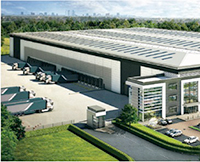
When it comes to marketing their merchandise, retailers are anything but shy. Yet ask questions about trading figures and almost anything related to operational performance and the shutters rapidly come down.
The obsessive secrecy that pervades the retail world supposedly ensures that competitors can’t steal a march on their rivals, but it also means providing the right sort of warehouse space in the right locations is more challenging. However, there is always insight to be gleaned from existing behaviours.
The disruption in the retail market caused by e-commerce means that logistics property specifications are likely to become increasingly bespoke, so the days of a standard warehouse are well and truly over.
This is causing headaches for developers, who are finding it increasingly difficult to second-guess which retailer might be attracted to the latest warehouse. Examples of buildings being adapted once a retailer has signed up are becoming ever more common.
Some developers, like Myles Hartley, managing director of Yorkshire-based Caddick Developments, suggest guessing is not advisable. His firm has just completed a 1.3m sq ft regional distribution centre for TK Maxx, now owned by Tritax. “There is no way that building could have been specced because it has a higher parking ratio than normal and required 700 piles to support the mezzanine level,” explains Hartley.
Happily for developers, a buoyant market means there is little need for speculative building at present. The biggest challenge facing both developers and their retailer clients is a shortage of industrial land around the UK’s major conurbations.
“Some retailers are searching for up to eight years to get the right size plot,” says Amy Gilham, head of logistics at planning specialist Turley.
However, the pressure of last mile delivery and click and collect mean retailers can no longer wait that long and they are already starting to compromise, with requirements for 50,000 sq ft buildings on two-acre plots reducing to 40,000 sq ft on one and a half acres.
For some retailers the answer may be second-hand buildings, while for others the solution may require them to share. “Retailers are getting together with collaborative solutions, but sharing is not a comfortable concept for them,” says Andrew Rosling, head of retail at law firm Addleshaw Goddard.
Developer SEGRO is considering construction of a large consolidation centre in East London. Are these the future for retail logistics needs? SEGRO director Alan Holland is cautious: “It is not something that will necessarily happen tomorrow, but a small number of strategically located centres across London is certainly possible.”

Retail giant floors new warehouse
The risks of speculatively building warehouse space for retailers are perfectly illustrated at Manchester’s Airport City, where MAG and Stoford jointly started construction of a 260,000 sq ft warehouse. The building was subsequently let as a fulfilment centre to Amazon, which started operations in September 2016, but not before they made some alterations.
The planning consent obtained for two additional mezzanine levels, to effectively triple the interior floorspace, meant that the original floor slab was not strong enough for the extra weight. Industry insiders report that it was therefore necessary to dig it up and replace it with a stronger one.
Return to sender – new-builds on horizon?
The sharp rise in retail returns is one of the hottest topics among retailers and one that has no simple solution.
“Retailers want to get stock back into the supply chain as soon as possible, so for many types of product (like fashion) they will want to integrate returns with their existing distribution properties,” says PwC director, consulting Tom Woodham.
But the sheer volume of goods flowing in the ‘wrong’ direction, together with the additional labour requirements in areas where accessing staff may already be difficult, mean that retailers may have to look beyond their existing logistics property network.
Some already are, confirms David Binks, industrial & logistics partner at Cushman & Wakefield. “A number of retailers are looking at significant-sized buildings for returns centres,” he says, adding that the sites he has scoped have been across the UK, so it is unlikely that returns hotspots will appear. “A returns warehouse could potentially be anywhere as it is not a revenue-serving centre but a cost-saving one,” he adds.
However, industry experts who engage regularly with retailers are currently divided about whether surging retail returns will translate into new warehouses. Some believe that several will soon emerge, though they are likely to be outsourced to third parties. Others, like PwC’s Woodham, are more sceptical. “Dedicated return centres will only work for certain types of products, such as consumer electronics,” he says.
Coming around again – second-hand sheds
In the same way that online shopping pushed the sale of pre-owned goods into the mainstream, now retailers may be looking at former warehouses.
Lack of supply in and around London and the South East is giving old warehouses a new lease of life. “Thought to be obsolete, they are now being considered by operators who previously wouldn’t have looked at them,” says Rapleys partner Colin Steele. “One of the attractions of second-hand stock is that it is here and now. A new-build in nine months might not tick the box, whereas an existing building is ‘job done’ even if it’s not ideal.”
That doesn’t mean every old warehouse within an HGV trailer-throw of the M25 is suitable for retailer needs, warns Seth Love-Jones, partner at TFT, who points that while many aspects of a building can be chopped and changed into what’s needed, issues like access – potentially for hundreds of van movements each day – can be harder to solve. “Retailers really need to go through due diligence very carefully,” he advises.

May the force be with you – 3PL insight
Neil Weightman, commercial director at 3PL iForce, is used to variety. “Every conversation I have with retailers varies considerably,” he says.
“Often they have the legacy of 10 or 15-year leases they are still tied to, and are working out how to best integrate those properties in their chain.” Weightman says that the shift to multi-channel retailing has undoubtedly made retailers’ supply chains more complex. One result is the desire to locate fulfilment centres as close to main carrier hubs as possible, which has led to a concentration of demand in places like Birmingham, Milton Keynes and Hatfield. That, in turn, has depleted the amount of available workers in those areas.
“If the labour pool is polarised in key areas, warehousing will fragment away to a certain extent,” says Weightman, who believes that, despite advances in automation, humans are still going to be in demand for some time to come. “15 to 18 years after e-commerce started there are still a lot of things that can’t be automated,” he observes. That could present opportunities for developers away from the traditional carrier hubs, but with a plentiful labour supply.
The impact of an increased level of returns on property requirements is more complicated. “There isn’t a one-size-fits-all solution for how returns are handled,” Weightman insists. Depending on the retailer and the product, returns may go back to a national or regional distribution centre, be shipped to a refurbishment centre, or end up at a warehouse within a 20-30-mile radius of a regional distribution centre.
iForce already includes returns areas in all of its UK warehouses and Weightman admits that it is quite possible that the company will take on running dedicated returns centres in the future.











